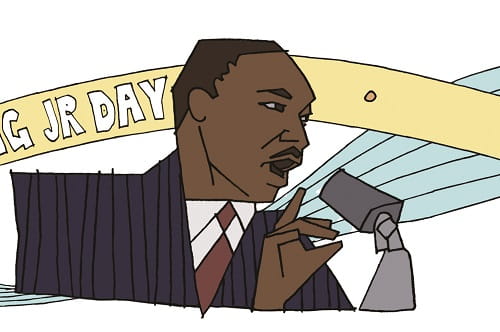One of the things that initially attracted me to Montessori education was its focus on nurturing the whole child. Over my almost 30 years in education, I’ve had the opportunity to analyze what it looks like to follow—and nurture—the child optimally. This led me to a question: How is a child’s unique identity amplified or muted by our environments and approach? This guiding question has set me on a deep dive into the science behind identity construction and, for the purposes of this article, how a healthy identity relates to the holidays we recognize (or not) in our learning communities.
Where to begin? As the AMS director of anti-bias, antiracist education Maati Wafford reminded me, Dr. Montessori called for the need for a “systematic study of self.” Preparing oneself as a practitioner includes recognizing, then unlearn-ing, assumptions and biases that we are conditioned to acquire. Without this work, Montessorians are destined to perpet-uate an educational approach corrupted by implicit biases and systemic oppression.
I contend that as Montessori practitioners, we are committed to the kind of preparation that enables us to discover the very nature of the child, just as Dr. Montessori implored us to with these words from The Secret of Childhood: “The adult must find within [themself] the still unknown error that prevents [them] from seeing the child as [they are].” (p. 11)
As an expression of personal and group identity, recognizing holidays conveys to others what you and your school value. Just to be clear, I am not suggesting that the onus is on you to nurture a healthy identity in a child solely through your holiday approach. Each child constructs a complex identity through experiences with their environment, including the holidays observed and valued by their family and broader culture. When a school community represents a child’s family culture by intentionally learning about a holiday important to that family, the message of inclusion is clear to all, and the child’s universal need for belonging and a sense of significance is amplified. Preparing an environment as a mirror that accurately reflects each child’s identity through an equitable holiday lens aligns with the Montessori mission to free the child’s potential. The impact of this approach is clear: “A child’s soul is like a bright mirror on which any breath can cast a shadow” (Montessori, the 1946 London Lectures, p. 204).
When children see the beautiful diversity of the world through authentic experiences with a wide range of holidays, it nurtures a sense of appreciation for and a celebration of differences. These windows into the cultures of peers near and far create a sense of communion, an essential force in building a critical consciousness that reveals the interconnectedness and interdependence of all things. This critical consciousness is also a necessity for dismantling systems of oppression.
It’s important to provide an accurate representation of holidays currently observed in your community, as well as to introduce holidays outside of the community: the mirrors that reflect a child’s identity back to them and the windows into cultures that share how others celebrate differently are imperative to the healthy development of the children. As stated before, a school’s or organization’s approach to holidays has the power to amplify a child’s sense of belonging and significance. Cultural mirrors and windows offer students opportunities to experience both our interconnectedness and our interdependence, key features of Montessori’s Cosmic Education.
Montessori environments are carefully curated with the tools for students to construct their whole being, yet as vitally responsive practitioners, we lack a playbook that provides a scope and sequence of lessons for cultivating an equitable holiday approach for a healthy construction of identity. It’s reasonable that there is no Montessori album of holidays, as there is no one formula that meets the needs (or in this case, culture) of every child in every community. Instead, we must rely on a framework of principles that lead to a more just approach to holidays.
In coaching guides and schools to build an equitable holiday approach, I have landed on fundamental principles for best holiday practices that serve as a framework guides can use to respond to their students’ identities. Several of the most important include “educate rather than celebrate,” “stay in your lane of experience,” and “do your homework” when in doubt. Your Montessori learning community has specific needs within the context of your place and time, and the principle of “consider your students” requires a customized approach to meet the needs of differing ages and abilities. Defer to primary sources for sharing information about holidays, and build a community agreement regarding what, when, how, and why holidays are recognized, all the while looking to your students: this is about their unique identities, not a curriculum that is reflected in the color of objects on your Practical Life shelves.
In the pages that follow, I have collected wisdom, stories, and resources on holidays from esteemed colleagues and Montessori guides Seemi Abdullah, Shalisa Agam, Kim Anh Nguyễn Anderson, Lucy Canzoneri-Golden, Tracey Cordero, Britt Hawthorne, Tatenda Blessing Muchiriri, Ashley Speed, and Maati Wafford. Their words illustrate principles for implementing an equitable holiday approach and the manifestation of critical consciousness in action.
TAMMY OESTING: How can a school’s holiday approach magnify or muzzle Montessori as a form of liberatory education?
MAATI WAFFORD: It is important to take a moment to emphasize here the need for what Montessori described as a “system-atic study of self” when we begin to look at the critical consciousness of the Montessori educator. While this article is cen-tered around how to bring an equitable holiday approach, how we go about curating authentic experiences for students and the true acknowledgment of what hinders that equitable approach is at the core of this conversation. In fact, this line of inquiry should be at the core of every conversation if we truly want to actualize the liberatory nature of Montessori ed-ucation, particularly for educators and children who have been targeted and/or marginalized.
As a Black Montessori educator, my approach to building a critical consciousness has required a very explicit understanding of the cultural practices and worldviews that lie at the heart of people of the African diaspora. As a young child and teenager, these early lessons were not made available to me in the classroom, nor have I personally found that my own children received this level of identity development in their Montessori communities. The interconnectedness and interdependence of all things is a concept found in many African and Indigenous cosmologies. While we know that the notion of bringing in mirrors and windows is key in our prepared environments, as educators we also must grapple with the ways in which we are limited by our own biased upbringings and perspectives and how those limitations can cause further harm and identity threat in our learning communities. This is ongoing, lifelong, internal work that cannot be bypassed or captured in any one professional development or book club. When I think of what critical consciousness means to me, I am quickly reminded of how important the art of unlearning is, to disrupt the various ways that society has told me that my people are not educable, not beautiful, and ultimately not human.
TAMMY: Do holidays amplify or mute inclusion of diverse identities?
ASHLEY SPEED: I think specifically gendered holidays, like Mother’s Day and Father’s Day, are not inclusive. I know that is a very loaded emotional conversation for a lot of people. I’m a mother myself; I’m cisgender but I am queer. I love getting Mother’s Day cards from my daughter’s school, but it is a holiday where lots of families feel excluded.
I know plenty of people who lost their parents at a young age; my husband’s mother died when he was 6, and Mother’s Day was always awful at school for him. Until about 8 years ago, I hadn’t really ever thought about it. It was just something that we did in my classroom; there was an expectation that we would make Mother’s Day gifts. Then I had a student who was the child of a single mother, which started me thinking that there were better ways to recognize and celebrate beloved caregivers.
Now, I have a lot of single parents, queer families, and families who live in multigenerational homes with children primarily cared for by their grandparents; these families may feel uncomfortable with celebrations that aren’t explicit about how they belong. I am in a school where I have more influence over changing traditions, so our students can bring whoever they want to our celebrations. We have a Bring Your Grown-Up Night that we schedule between Mother’s and Father’s Day, and we let the child choose who they want to bring. We also have a Family Spring Tea. I prefer these to gender-specific holidays; they ensure the implicit message of inclusion to all community members.
TATENDA BLESSING MUCHIRIRI: Holidays are about bringing people together as a community. They foster unity. They celebrate uniqueness in the midst of diversity. Cosmic Education is about helping the child find their place in the universe. Teachings about holidays help students recognize their uniqueness and that of others, and how all these differences contribute to the creation of one community, the human race. Holidays in the Montessori setting should foster appreciation and respect.
Holidays intrinsically possess the power to grow beyond the original culture. There are calls from the conservative quarters of the Montessori community to preserve holidays in pretty much the same way preservation societies take care of historic buildings. This is not possible. The regrettable origins of many beloved American traditions will always be an embarrassing footnote to what the holidays themselves have evolved to represent. Montessori should neither whitewash nor demonize these. Instead, there should be a concerted effort to show how these holidays have managed to outlive their legacies. The Montessori community should in fact look into how it can take on some of these resilient characteristics and use them to displace conventional educational systems. Holidays are living institutions and should be treated as such. I believe teaching about holidays should not only honor their histories but also include discussions on how they are evolving and expanding to accommodate our ever-shifting demographics and a changing world.
I remember the first time I got to celebrate Kwanzaa [in a classroom]. I was very excited about it because I had always assumed, like many people, that it is a holiday that originated in West Africa. I am from Zimbabwe, in southern Africa. I decided to do a little research and discovered that Kwanzaa is an entirely American invention! I felt an initial disappointment, which then congealed into a strange confidence: I realized that all people from all places can come to the United States and find a way to add their unique imprint onto the tapestry of American culture.
There are other holidays in this country, like Juneteenth or Martin Luther King, Jr., Day, which speak to our civil rights. Kwanzaa makes a connection that stretches all the way back to the African motherland. It is truly the first holiday that recognizes all Black people irrespective of their origins. It condenses the diversity within the Black community, yet creates a new kind of unity and solidarity.
TAMMY: How do you feel holidays in Montessori schools ought to be approached?
SEEMI ABDULLAH: When I was teaching, we had a pretty international group of families at my school. My approach was to invite families to come in and share their family traditions all year long. I also incorporated holidays and celebrations found in the local community that children would be exposed to as they went about daily life. Our students, their families, and school staff were receptive to all of it.
A holiday approach needs to be a visible and consistent part of the school culture—not just reserved for “cultural week.” It is important to invite parents to share their heritage and holidays, and then also to share photos about their visit with the rest of the community, to encourage others to reach out when they have something they’d like to share. Setting the stage for family engagement with an initial Family Heritage Survey and including the invitation as part of the school tour gave families time to process before the monthly call for engagement was released in our newsletter. Once we got to know each other better, some families would volunteer to present their family customs for a particular holiday, while others preferred to decline sharing, which was equally respected.
Photos of family holiday visits were highlighted in several ways, including on a clothesline pinned with photos, in a work where children could place a selection of photos into a frame, in our school newsletter, and on a corkboard where children created a photo collage. One family showed us how to make rangoli designs for Diwali; for Eid, another family shared dates, brought clothes to try on, and showed us all how to write our names in Arabic; and yet another family shared about Yom Kippur and brought apples and honey for a snack.
Our cultural climate of voluntary engagement created space for our families to express their values and beliefs through rituals and, more often than not, observance of holidays that illustrated these beliefs.
Holiday Book Recommendations for Montessori Classrooms
by Ashley Speed

Tastes Of Lunar New Year
By Cheryl Chepusova, 2020, Ages 3–6
This book highlights Lunar New Year food traditions from China, Singapore, Malaysia, Taiwan, Hong Kong, Vietnam, and Korea. While Lunar New Year is celebrated by billions of people across the world, it is rarely depicted in children’s books as being as multicultural as it truly is. The many cultures of Asia are not interchangeable, and the way Lunar New Year is celebrated in China is not necessarily the same as it is in Malaysia— this book really embraces the multiculturalism of the holiday.

Behind The Mask
By Yangsook Choi, 2006, Ages 5–8
This book features a young Korean boy who is going to dress up as his grandfather for Halloween, which his friends don’t think sounds very scary. But they don’t know that his grandfather was a Korean mask dancer! Remember that families who celebrate very Americanized holidays, such as Halloween, are not all white, and that different families, especially immigrant families, blend their own heritage and culture with the culture of their new homes. This book embraces these intersections of identity beautifully.

The White Nights Of Ramadan
By Maha Addasi, 2017, Ages 6–9
This gorgeously illustrated (truly, it is lush and beautiful) book talks about a little-known Ramadan tradition called Girgian, which is celebrated in communities in several Persian Gulf states, including Qatar and the United Arab Emirates. It is a beautiful depiction of a cultural tradition. I love how the story shows that not all Muslim communities are the same and that different cultures within the broader community have specific traditions of their own.

This Day In June
By Gayle E. Pitman, 2014, Ages 2–5
This bright, rhyming book features a Pride celebration and includes colorful depictions of many of the groups one sees at modern Pride fests. It’s joyous, fun, and a sweet introduction to this celebration of hard-won human rights. There is a glossary at the back for adults, and I love that this book shows that Pride is for all, including children, and illustrates that queer children and families exist.

The Purim Superhero
By Elisabeth Kushner, 2017, Ages 3–6
While the most well-known of Jewish holidays to the non-Jewish world is Hanukkah, the Jewish year is actually full of holidays. Purim is beloved by Jewish children around the world, as it features costumes, candy, and parties. This book is a wonderful story about staying true to yourself; it features a Jewish family with two dads, and it highlights the joy of the Purim celebration. It’s so important to shine a light on holidays that are significant to the communities that celebrate them, rather than merely the ones most well-known to the larger world—and this goes for all cultures, not just Judaism.
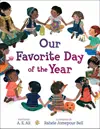
Our Favorite Day Of The Year
By A. E. Ali, 2020, Ages 3–6
This book is one of my recent favorites. It follows a school year, beginning with the kindergarten teacher telling her students that the first day of school is her favorite day. One by one, a group of children share their favorite days with their class—Eid, Rosh Hashanah, Las Posadas, and Pi Day. This beautiful story does a wonderful job of showing that not everyone celebrates the same things and that we can embrace those differences and share in the joy of them.

Let’s Celebrate Diwali!
By Anjali Joshi, 2015, Ages 3–6
Diwali is celebrated by families across India and throughout the world where large Indian populations are found. This book is spectacular because it discusses how different Indian families—Hindu, Sikh, Jain, and Buddhist—celebrate this festival, again reminding us how cultures and communities are not monolithic.

Is For Kwanzaa
By Juwanda G. Ford, 1997, Ages 3–9
This sweet, boldly illustrated Kwanzaa alphabet book is absolutely worth tracking down. It is packed full of information about a holiday not very well known outside of the United States. I’m Canadian, and I learned so much from this book. There are lots of lovely stories about Kwanzaa on the market—many from recent years—but this stunning, nearly 25-year-old classic is the perfect introduction to this unique holiday.
SHALISA AGAM: I remember starting my new career as a guide at Montessori Jewish Day School and having a window opened to me to the richness of culture, community, and togetherness of the Jewish identity. I saw this in how the holidays were approached in the school community, as an educational experience.
I feel holidays from all cultures should be approached as a cultural lesson and as a window of opportunity to look at how a specific holiday is observed. As children learn about different holidays and connect to other holidays’ use of food, fashion, and fiesta—the “3 Fs” of most holiday celebrations—they get a visual understanding that differences can also be similarities. When a child feels seen and heard when it comes to the holidays they celebrate, and is able to share this part of themself with their peers, it facilitates understanding and growth.
As a particular holiday approaches, setting up a table or space in the prepared environment with content related to that holiday celebration provides a haptic experience for the child. The table could contain images of children celebrating, traditional food items, clothing or special items to be worn, objects used to celebrate, and books about the holiday.
Look within your school and class communities to learn from the children about their identities, and showcase the holidays they find special. This will help support a diverse environment. Look to parents and families for guidance on holidays you may not be knowledgeable about. If a holiday is one you do not celebrate yourself, use the resources that are available to you—families, colleagues, books, videos—to showcase the holiday appropriately and respectfully.
Be mindful of not just celebrating the dominant holidays found on a bank calendar or filling the seasonal shelves of the grocery store. Rather, aim to create a voice and a narrative for all the cultures in the school community. The more knowledge the children have in their prepared environment about other cultures and holidays, the more windows of understanding of humanity will be accessible to them.
Book Recommendations for Educators
by Britt Hawthorne
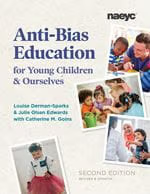
Anti-Bias Education For Young Children And Ourselves
By Catherine M. Goins, Julie Olsen Edwards, and Louise Derman-Sparks (2010)
Anti-Bias Education for Young Children and Ourselves offers educators four goals to lay the foundation to create a truly inclusive classroom. Inside you will find examples of teacher experiences and concrete examples to move the work forward. The approach to holidays is focused on celebration, relationship-building, and reducing unintentional harm. If I had to choose just one book for educators to learn about equitable holiday celebrations, this would be it.
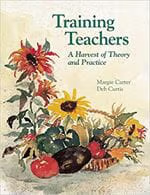
Training Teachers: A Harvest Of Theory And Practice
By Deb Curtis and Margie Carter (1994)
Training Teachers is a practical, strategy based book with tools to support teachers to create an anti-bias learning space. This book also uses four anti-bias education principles for holiday celebrations and lists how to approach holiday activities through dramatic play, music, cooking, etc. There is also a worksheet for holiday decision-making to help teachers create a program relevant to their classroom. If you are ready to move from theory to practice, this is your book.
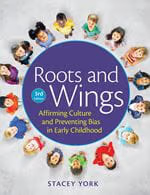
Roots And Wings: Affirming Culture And Preventing Bias In Early Childhood
By Stacey York (2003)
For educators looking for information about how to ensure activities are developmentally appropriate, Roots and Wings offers information about developmental stages, activities for you to try in your classroom, and culturally responsive learning objectives and values. A planning process is offered to help you carry out culturally responsive care in education in 11 steps. Flip to the section that specifically addresses how to talk with caregivers about including their cultural celebrations. This book also includes a classroom book list that supports anti-bias education.

Celebrate! An Anti-Bias Guide To Including Holidays In Early Childhood Programs
By Julie Bisson (2002) Celebrate is an anti-bias guide all about holidays. There are ages and stages for holidays for children from 2 to 5 years old, yet this book is an excellent resource for approaching holidays at every age. You’ll find important information on how to accurately honor certain holidays, like Thanksgiving, and how to include social justice holidays in your program. Key sections include addressing holiday stereotypes, the commercialization of holidays, holiday evaluation questionnaires for families, and suggestions for classroom books specifically about holidays.
TAMMY: Has your personal identity been fairly and accurately represented and expressed in the school holidays you’ve expe-rienced?
TATENDA: I come from a predominantly Christian community in Africa. I have seen aspects of my faith reflected in the cele-brations of Christmas; however, there are some uniquely African observations to these holidays that are missing from the discussion in this country. The more holidays spread into dominant culture, the more they are adapted to satisfy local con-ditions. For example, Christmas was initially derided and even banned in puritanical New England, on account of the rau-cous nature of its revelries in Europe. However, the replacement of the European traditions, along with the addition of America’s own commercialistic imprint, allowed Christmas to not only take root but to be reexported the world over in its revised American visage.
One February, I was working as a supporting teacher in a Montessori school in Colorado. To recognize Black History Month, the lead teacher was showing a short video about Dr. Martin Luther King Jr. to a group of Primary children. After the video, the class discussed racism, tolerance, and acceptance.
As the only Black person at the school, I was a quick example to her narrative on the work done to make it possible to have people like me in the same space with a group of white children. This happened in a diverse classroom of children: some were from Asia, and others were mixed-race. I was surprised to learn that I was the only person to be used as an example, the only Black person to be an aid for understanding her narrative. If I was not there, I wondered, what stories would she tell?
This went on almost every week of Black History Month. The final blow to my humanity came when I was asked to talk about Nelson Mandela. Believe me, on any given day, I’m excited to share the Nelson Mandela freedom story. But that day I wondered, is it because I am Black and from an African country that I’m being asked to speak about Mandela? Did she think I was too far removed from U.S. history to talk about Dr. Martin Luther King, Jr.? I remember forcing a smile as she promised children about a wonderful next day with Tatenda sharing about an African peacemaker: Nelson Mandela.
I went home that night, troubled by being tokenized, misrepresented, and othered. But these troubled thoughts also brought me some light, a new understanding of myself and an unleashing of my voice. I vowed to myself to share my story, to celebrate myself, my family, and my people. I woke up the next day and went to school with an album of photographs to share with children in my class about my family and my travels, achievements, and celebrations. I wanted to give them a practical experience to celebrate Black history and their Black teacher in front of them—a story they could relate and connect to the macro experience of Nelson Mandela, Dr. King, Jr., and Rosa Parks.
This entire experience gave me a new outlook on how we share Montessori with people of the global majority. I gained insights into how my story and the stories of my people are shared with people who do not have direct, lived experiences and knowledge of Black people.
If anything, Montessori is nothing but the story of my people; it is an education rooted in community learning and deep knowledge of ubuntu/unhu (a collective social responsibility to one another).
TAMMY: How do you see the role holidays could play in decolonizing Montessori?
TRACEY CORDERO: The first thing that comes to mind when we talk about holidays is whose calendar system we are using. That’s usually where we see holidays first. Whose calendar are we using for our holidays, and who is it meaningful for? In our white supremacist society, what is centered, and for whom? Until very recently, Columbus Day was a national holiday; what does that say to a nation of Indigenous people about how this country came to be and who we are as a people in modern existence, not even in a historical context? It’s 2021. Don’t we know better than to celebrate Christopher Columbus? Think about the 4th of July: Who is that holiday for? What is the meaning behind Independence Day? Independence for whom? According to whom? When July 4th was first celebrated, in 1777, Indigenous people were not seen as human in the Constitution. We didn’t get a right to vote until very recently. So it’s those kinds of holidays that continue to center white supremacy and that continue to perpetuate systems of racism that continue to devalue us and further make us invisible as a people.
Whitewashing history in modern day through the calendar is continued by a lack of acknowledgment that we are here. Another example is Memorial Day. We recognize veterans on this day, and while I don’t want to take away from that, in truth, this country wouldn’t exist if it weren’t for the Indigenous warriors, the Navajo code talkers, who contributed to the World War II effort by passing coded messages through their language. That’s well-documented, but it is not highlighted and centered nearly enough as it should be. There’s no reason for that not to be its own holiday.
Why is the Western calendar taught in Montessori, which is supposed to be a global approach to education? Why aren’t we training teachers to be more inclusive of calendars of other communities? Why don’t we ask our students and community to contribute to what the “standard” calendar is? It could be a seasonal calendar, something that ends and begins with solstice days, rather than January 1st to December 31st.
There are so many options, and there is so much potential for Montessori to do more with a calendar. Easy, minor tweaks to school calendars could make such an impact on systemic issues. Why not turn that into a lesson? Why not ask the community, guides, children, and parents to develop the material that is appropriate for putting together a calendar in their communities?
MAATI: When I think about ways to bring an equitable holiday approach to children, I would begin by sharing how many of our holidays are extensions of how people organically lived with and communed with nature. This is important to highlight because, through the colonization process, not only were some of these practices violently stripped away from people of color, along with their languages, drums, religion, and other ways of communication, but also just as destructive was the disruption of how people orient themselves in time and space. Many holidays are essentially rituals and festivals that honor the harvest, the change in seasons, the moon cycles, celebrations of births, and the continuum of life and afterlife as elders transition to the ancestral realm. Many of our holidays are powerful reflections of pre-colonized notions of community, time, and reverence for nature and spirituality. One way we can commit to dismantling oppression through our study of holidays is to be explicit about the intelligence and innovation of people of the global majority. Another way would be to look critically at the impact of settler colonialism and consumerism on many of our holidays and cultural practices.
LUCY CANZONERI-GOLDEN: When I think about holidays and my more than 40 years of experience as an educator who identi-fies as Latinx and a person of color, I can’t help but realize how problematic holidays have been, especially for BIPOC (Black, Indigenous, people of color) children. As a public-school teacher for many years, and even after I became a Mon-tessori teacher after 7 years in education, holidays always centered whiteness and Eurocentric perspectives. I went along with it like many people, even when we started our school over 20 years ago.
The most problematic holidays had to do with the erasure of Native Americans, especially during Hispanic Heritage month and Thanksgiving, where children were allowed to make pilgrim and feathered bands and called Columbus an explorer, when he was an invader. Thankfully, we now have discussions through our CRP/ABAR (culturally responsive pedagogy/anti-bias, antiracist) work where we encourage our staff and students to dig deep to uncover the lies we’ve been told and to begin to unlearn what we were taught.
The Native people of this land have been assaulted in such a manner that is beyond horrific. We must take responsibility for past mistakes. We have to do better by supporting our local Native communities. My son, who’s a filmmaker and was Montessori-educated from ages 3 to 14, stated: “Why bother continuing my education post high school? It’s a waste of time, and everything they call education in the U.S. is dishonest and promotes the narrative of white supremacy.”
We are now on the precipice of major transformation. If we want to dismantle the toxicity of education, we can do this as Montessorians as long as we do the work, decenter these white supremacist practices and systems, and support BIPOC educators committed to leading this work.
TAMMY: Can you tell a story about when a holiday amplified or muted a child’s (or your) identity?
KIM ANH NGUYN ANDERSON: I casually open a book as I tell my Upper Elementary students the story of Tết, the Vietnamese Lunar New Year celebration. Of course, I start with the topic that catches their attention the most: firecrackers. Then I talk about how watermelon used to be harvested only in one season, Tết time, in Vietnam. I share that feeling when a child waits for the whole year to get to eat certain foods, play Tết games, stay up late, and get lì xì (lucky money).
The topic of lucky money also gets their attention! “Are you going to give us money? How about you give us 5 dollars!?” I smile as I realize this book reading is like no other reading occasion. I told them only children and elderly people receive lucky money. For children, it is lì xì, and for adults (older parents, grandparents, older aunts and uncles), mừng tuổi is translated as “we wish you health and longevity.”
The conversation has now really heated up. Being Upper Elementary students, the children really want to solve the mystery of whether they will get some lì xì money from me! I never fail to keep a secret; they just have to exercise patience and wait.
Out of this continuous firecracking conversation comes another question from a student: “So what are you going to do this year for Tết?”
“I’ll call my parents to wish them mừng tuổi before I go to work . . . and maybe cry a bit.”
“Oh. Don’t cry!” they reply. I go on to tell them that, like many adults, I romanticize Tết from back when I was growing up. I also tell them, “I wish my workplace recognized Tết and included it as a day off for people of Asian ancestry who celebrate Lunar New Year here in the U.S.” Tết conversations continue daily, and I welcome my students’ questions.
A sense of togetherness and unity is what I want to share with them. Equally important is a sense of gratitude for my parents and our ancestors. I want them to understand my culture and what it was like to grow up outside of the U.S. It’s natural that a sense of filial piety (hiếu) comes to mind first. Everything I do is guided by some aspect of hiếu—for better or worse, and consciously or subconsciously. Organizing my thoughts, I begin to write about my father:
My father always smelled like flowers, even after he had bathed. When he was not busy working on his flower farm, he would sit on the floor of his open, sunny, spacious living room overlooking the little flower valley. I could count the wrinkles on the sides of his eyes when he summoned a look of concentration. With a big mug of green tea in his right hand and a piece of sweetened ginger in his left, he would let his mind ponder for what seemed to be hours. I watched my father like this many times. Should I have asked him what he was thinking at the moment behind his heavily creased face? Into each crease he had tucked some worry or other so that it wasn’t his own face any longer, but more like a persimmon tree that had nests of birds in all the branches. He had to struggle constantly to manage the family, the finances, and the farm, and always looked worn out from the effort. I dimly realized that I was one of the nests that had settled for a long time on one of his branches.
Holidays at
“Case Study Montessori”
The month of December unfolds, and a toddler at Case Study Montessori notices the battery-lit candle on the shelf that looks just like one of the diyas at their Nani’s house. They excitedly turn the candle on and off for the next 5 minutes. Down the hallway, a child in the Casa sits down in the library with a copy of Our Favorite Day of the Year and later enacts the Las Posadas story on the playground, replete with a friend acting as a braying donkey. Meanwhile, in an Elementary classroom, a small group of students works with the Fundamental Needs of Humans chart and spontaneously creates additional card material for holidays that celebrate light, while yet another group researches the historical origins of current Christmas customs around the world. The classroom guide overhears several exclaim that their family celebrates with different and similar traditions. That afternoon, the faculty meets to discuss how their intentions in creating a more child-led educational approach to holidays had increased meaningful inquiry into the similarities and differences of human culture. The discussion veers into how to approach the next month, who has firsthand experience with upcoming holidays, and what primary resources the team could lean on to accurately represent holidays not observed by their current community members. The team makes a plan to continue to capture the joy of learning about oneself and others not currently in the community, with the intent of respectfully highlighting Case Study Montessori’s mission of unleashing each child’s potential and healthy development.
Curated By
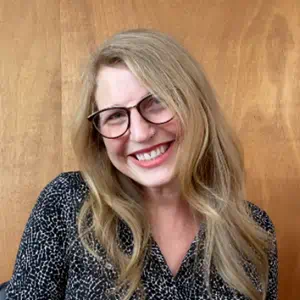 | Tammy Oesting (she/her) has spent the last 26 years delivering professional development workshops, consulting for schools, and educating new Montessori teachers. She is AMS-credentialed (Early Childhood, Elementary I–II). |
Participants
 SEEMI ABDULLAH, MEd, (she/her) is the founder and CEO of TrilliumMontessori.org, which provides affordable, self-paced professional development opportunities and curriculum resources for Montessori professionals to take their practice to the next level. She is AMS-credentialed (Early Childhood).
SEEMI ABDULLAH, MEd, (she/her) is the founder and CEO of TrilliumMontessori.org, which provides affordable, self-paced professional development opportunities and curriculum resources for Montessori professionals to take their practice to the next level. She is AMS-credentialed (Early Childhood).
 SHALISA AGAM (she/her) has been a Casa guide at Montessori Jewish Day school in Toronto, Canada, since 2008. Shalisa has a great interest and passion for learning and facilitating a child’s journey through observation. She is AMS-credentialed (Early Childhood).
SHALISA AGAM (she/her) has been a Casa guide at Montessori Jewish Day school in Toronto, Canada, since 2008. Shalisa has a great interest and passion for learning and facilitating a child’s journey through observation. She is AMS-credentialed (Early Childhood).
 KIM ANH NGUY N ANDERSON, MA, (she/her) is a Montessori edupreneur, teacher trainer, and evolving writer- teacher. Living and working in both English and Vietnamese, she developed a love for writing in both languages in high school. Her mission in the Montessori literacy space is to get teachers and students excited about writing and to engage in her own daily writing to nurture personal growth. She is AMS-credentialed (Early Childhood, Elementary I–II).
KIM ANH NGUY N ANDERSON, MA, (she/her) is a Montessori edupreneur, teacher trainer, and evolving writer- teacher. Living and working in both English and Vietnamese, she developed a love for writing in both languages in high school. Her mission in the Montessori literacy space is to get teachers and students excited about writing and to engage in her own daily writing to nurture personal growth. She is AMS-credentialed (Early Childhood, Elementary I–II).
 LUCY CANZONERI-GOLDEN, EdD, (she/her) is co-founder and codirector of Coral Reef Montessori Academy Charter School, in Miami, FL, an AMSaccredited school that predominantly serves students of the global majority. She is a pioneer in the field of teacher-led educational reform, providing an alternative to the top-down, expert-led initiatives that dominate urban education today. Her recent doctoral dissertation (with Dr. Juliet King, see page 25) researched and analyzed the perspectives of parents, teachers, and administrators on how culturally relevant pedagogy and anti-bias and antiracist curriculum operate in three urban public Montessori schools. She is AMS-credentialed (Elementary I–II).
LUCY CANZONERI-GOLDEN, EdD, (she/her) is co-founder and codirector of Coral Reef Montessori Academy Charter School, in Miami, FL, an AMSaccredited school that predominantly serves students of the global majority. She is a pioneer in the field of teacher-led educational reform, providing an alternative to the top-down, expert-led initiatives that dominate urban education today. Her recent doctoral dissertation (with Dr. Juliet King, see page 25) researched and analyzed the perspectives of parents, teachers, and administrators on how culturally relevant pedagogy and anti-bias and antiracist curriculum operate in three urban public Montessori schools. She is AMS-credentialed (Elementary I–II).
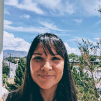 TRACEY CORDERO, MBA, (she/her) is a proud tribal member of Cochiti Pueblo and a mother, aunt, sister, daughter, and fierce community advocate. She served on the board of directors for the Keres Children’s Learning Center (KCLC) for 3 years and then became director of the Indigenous Montessori Institute. Her continued work with KCLC is rooted in the hope of fostering tribal sovereignty through Indigenous education. Her professional experience includes administering tribal court services and tribal prevention programs, strategic planning and consultation, and serving on various boards and committees.
TRACEY CORDERO, MBA, (she/her) is a proud tribal member of Cochiti Pueblo and a mother, aunt, sister, daughter, and fierce community advocate. She served on the board of directors for the Keres Children’s Learning Center (KCLC) for 3 years and then became director of the Indigenous Montessori Institute. Her continued work with KCLC is rooted in the hope of fostering tribal sovereignty through Indigenous education. Her professional experience includes administering tribal court services and tribal prevention programs, strategic planning and consultation, and serving on various boards and committees.
 BRITT HAWTHORNE (she/her) is a visionary and hands-on leader whose work moves the idea of equity in education from a goal to reality. She partners with action-oriented educators to create classroom environments that are inclusive and equitable for all learners. Britt speaks at conferences, authors publications, and appears on podcasts covering social justice, liberation, and equity in education. She serves on the AMI/USA Human Rights and Social Justice Committee and the advisory board of Sankofa Learning Center. She is AMS-credentialed (Elementary I–II).
BRITT HAWTHORNE (she/her) is a visionary and hands-on leader whose work moves the idea of equity in education from a goal to reality. She partners with action-oriented educators to create classroom environments that are inclusive and equitable for all learners. Britt speaks at conferences, authors publications, and appears on podcasts covering social justice, liberation, and equity in education. She serves on the AMI/USA Human Rights and Social Justice Committee and the advisory board of Sankofa Learning Center. She is AMS-credentialed (Elementary I–II).
 TATENDA BLESSING MUCHIRIRI (he/him) was born in Zimbabwe and discovered his love of Montessori when he moved to China, where he had the opportunity to work with children for 7 years before moving to Colorado, in 2015. He was a member of the AMS Emerging Leaders Fellowship in 2018 and a Moonshot EdVentures Fellow in 2020. Tatenda also serves as a board member for Colorado Montessori Association. He is AMS-credentialed (Infant & Toddler, Early Childhood).
TATENDA BLESSING MUCHIRIRI (he/him) was born in Zimbabwe and discovered his love of Montessori when he moved to China, where he had the opportunity to work with children for 7 years before moving to Colorado, in 2015. He was a member of the AMS Emerging Leaders Fellowship in 2018 and a Moonshot EdVentures Fellow in 2020. Tatenda also serves as a board member for Colorado Montessori Association. He is AMS-credentialed (Infant & Toddler, Early Childhood).
ASHLEY SPEED (she/her) is an AMI-trained 3–6 guide and popular Montessori and book Instagrammer (@ashspeedteaches). She is Jewish, queer, nonmonogamous, and neurodiverse, and her favorite thing to do besides teach is to spend time with her family. Her favorite holiday is Passover.
 MAATI WAFFORD, MSW, (she/her) is the former AMS director of anti-bias, antiracist education. She advocates for equity by creating avenues for the coexistence of science, spirit, and social justice in Montessori education. Her leadership focuses on building trust for engaging in direct, honest, and productive conversations about rooting the complex art and science of teaching in equity and justice. Maati is AMS credentialed (Early Childhood, Elementary I–II, Administrator).
MAATI WAFFORD, MSW, (she/her) is the former AMS director of anti-bias, antiracist education. She advocates for equity by creating avenues for the coexistence of science, spirit, and social justice in Montessori education. Her leadership focuses on building trust for engaging in direct, honest, and productive conversations about rooting the complex art and science of teaching in equity and justice. Maati is AMS credentialed (Early Childhood, Elementary I–II, Administrator).
References
Montessori, M. (1982). The secret of childhood (1st ed.). Ballantine Books. (Original work published 1936).
Montessori, M., & Foteva, L. (2019). The 1946 London Lectures [Montessori Series, Book 17]. Montessori-Pierson
Publishing House. (Original work published 2012).

